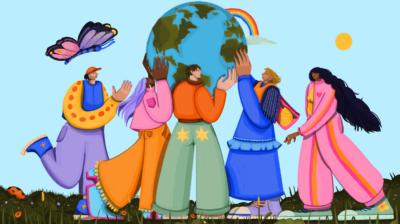What should you do with your clothes once you’re done with them
Discover ways you can get rid of clothes sustainably, by selling, swapping, upcycling, recycling or even donating.


Thinking of getting rid of some clothes? You may have things lying around in perfectly good condition that just don’t work for you because of their shape, style or size. While a wardrobe clear out can be refreshing, there is no reason those clothes should go to waste.
The amount of clothes we use and throw away is an issue for the environment. In Ireland, around 63,000 tonnes of clothing and other textiles are collected as household waste each year and this is processed via waste-to-energy plants or landfills, according to the EPA. The global fashion industry produced around 2.1 billion tonnes of GHG emissions in 2018, equalling 4% of the global total. We need to reduce the impact of the textile industry by changing it from a ‘take-make-waste’ system to one where prevention of waste, reuse, repair and recycling are a priority – this is also known as a circular economy.
In Europe people use around 26 kilograms (kg) of textiles and throw away about 11 kg every year – 87% of this waste is incinerated or goes to landfill.
Just because you’re finished with your clothes doesn’t mean they can’t have a second life elsewhere. Especially if they are in good condition.
How to dispose of clothes sustainably
There are lots of options to get rid of old clothes without having a negative impact on the planet.
Repair your clothes
Before you toss it out, consider whether the issue you have with a piece of clothing is fixable. For example, a broken zipper, a small rip, or a good quality piece with extra fabric could be revamped by a trip to the tailor or your local alterations shop.
Sewing is also a great skill to have if you have the time to do some research on simple techniques, so you can patch up elbows, darn a hole or reattach straps at home. You can also keep an eye out for virtual and in person repair classes from places like The Rediscovery Centre.
Shoes are fixable a lot of the time too. A cobbler can often mend a sole, stitch a hole, dye or recolour shoes and replace zips, velcro and buckles. repairmystuff.ie is a great way to start searching for your local repair business.
If there is some discoloration or a stain, you could dye your clothing a darker colour or tie-dye using coloured dye or bleach.
Reuse and upcycle
There are some great instructions and tutorials available online if you want to try turning something like a large old t-shirt into a crop top or a sleeveless shirt, just look up upcycling projects and you will be amazed by the possibilities!
If you have old socks or things that are past the point of being wearable, you can still find other uses for them rather than going straight for the bin. Try reusing them as cleaning cloths or make up pads. You can also cut fabric into strips and use them to make handmade rugs or macrame plant holders.
Swap or pass on clothes to friends and family
If you have clothing that’s in pretty good condition, consider giving outgrown or old clothes to a friend or family member. This could help them to save money, get something new to wear, and it prevents your clothes from getting thrown away. You could also try doing a swap with some friends, this can be a great way to refresh your wardrobe and try some new clothes while getting rid of things you don’t wear anymore.
Selling or donating old clothes
You might have some clothes that are in great condition or with the tags still on. Selling them on places like Depop, Etsy or Ebay can help you clear out your wardrobe and earn you some money in the meantime.
However, if you don’t have the time or patience to photograph items, write descriptions, message potential buyers and sort postage and packaging, selling might not be the option for you.
In this case you can gather the garments you have that are in good condition and donate them to a local charity shop. Read more on what you need to know before donating clothes to charity.
Recycle
As a last resort, there are clothing recycling centres and banks in Ireland that will take anything that you can’t donate, sell or reuse. Some clothing stores also allow you to bring back their old clothes to be recycled.
The only issue with clothing recyclers is that the material is often exported and the technology for recycling clothing is limited. Just 1% of recycled clothing is recycled as clothing so exploring other options before choosing this one is ideal.
What should I do with old underwear?
While everyone should try their best to keep their clothes and textiles out of landfill, sometimes it can be difficult. Charity shops might take underwear or bras that are essentially new but you will have to check when you’re donating.
Clothes pod has 1,200 banks in Ireland and they accept underwear that is clean and dry. Be aware that the clothing from these banks is exported around the world for resale or recycling – and most clothing sent for recycling is downcycled to furniture stuffing, carpet or insulation.
If you have badly stained underwear, old duvets or pillows there is often no other way to deal with them than putting them in the general waste bin. Keep this in mind when you’re buying items that can’t be recycled, sold or donated so that you go for pieces that will last a long time.
Doing your best to not let clothing go to waste is a great way to be more sustainable in your everyday life. Getting the most out of your clothing can help to reduce the impact it has on the planet. It can help contribute to a more circular economy where we consume less and create less waste.
Cover image by Cathy Hogan






